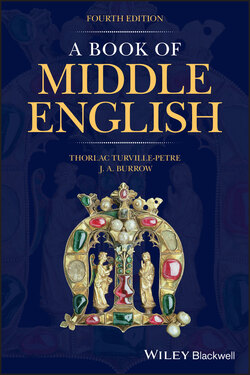Читать книгу A Book of Middle English - J. A. Burrow - Страница 46
4.5 Verbs 4.5.1 Introduction
ОглавлениеIn Middle English, as in Old and Modern English, the verb has just two tense‐forms, present and past. The way in which the past tense is formed divides the regular verbs into two classes, weak and strong. The great majority of verbs are weak and their numbers steadily increased, since most newly formed or introduced verbs were weak; also there was a tendency for verbs that were strong in Old English to become weak in Middle English. Many of the commonest verbs, however, are strong. The distinction between the two classes is that weak verbs form their past tense and past participle with ‘a dental suffix’, that is, an ending containing a d or t (e.g. in Modern English kill, laugh, learn, bend), whereas strong verbs form their past tense and past participle by changing their stem vowel in accordance with an ancient rule that goes right back to the remote ancestor of English, the ‘Indo‐European mother‐tongue’. Examples of strong verbs in Modern English are drive, sing, bear, choose. However, a few verbs both have a dental suffix and change their stem vowel (e.g. in Modern English seek, buy, bring, think); these are weak verbs, the change in their stem vowel not being ancient but having taken place in early Old English. See Guide to Old English, paragraphs 122–3.
The verb has three moods: indicative, subjunctive and imperative. The distinction between indicative and subjunctive is explained later (5.6.6); broadly, it is that the subjunctive is a non‐factual mood, used to express a doubt, hypothesis, conjecture, wish or the like. The imperative is used for orders and requests.
In the indicative mood, verbs may distinguish in form between the first, second and third persons of the singular, but all verbs have just one form throughout the plural (for we, ʒe and hi/þei). The subjunctive has just one form throughout the singular, to which it adds ‐n throughout the plural.
There are two participles or adjectival forms of the verb: the present participle (in Modern English the ‘‐ing participle’), and the past participle (used to form verb‐tenses with ‘have’ and ‘be’, and also as an adjective).
